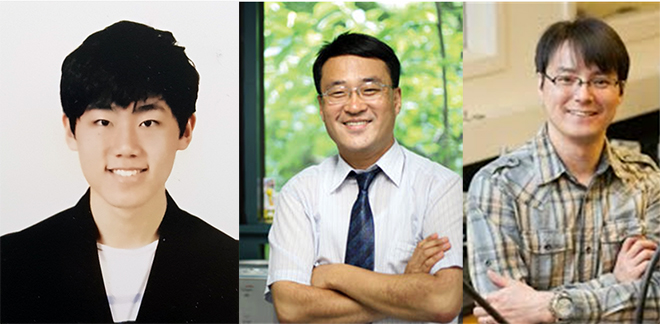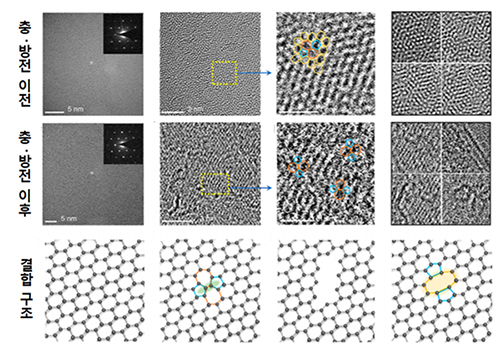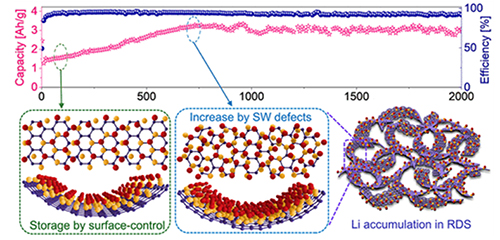Korea University-Gyeongnam National University of Science and Technology Joint Research Group Develops a High-Purity, Graphene-Based, Next-Generation Lithium Secondary Battery
The joint research group is the first in the world to identify the mechanism of additional lithium ion storage in pure graphene.
The results were published in ACS NANO, a renowned international journal in the field of nanotechnology.

The joint research group led by Professor Ju Byeong-kwon, School of Electrical Engineering, College of Engineering of Korea University and Professor Jung Hyun-young, Department of Energy Engineering of Gyeongnam National University of Science and Technology developed a pure graphene-based electrode that can greatly improve the capacity and stability of existing carbon electrodes. The group is the first in the world to identify the mechanism of additional lithium ion storage in pure graphene and realized a performance more than eight times higher than that of existing electrodes. The results were published in the January issue of ACS NANO, one of the top-tier journals in the field of nanotechnology.
*Graphene is a two-dimensional material in which carbon atoms are arranged in a hexagonal honeycomb structure. A material with more than 10 stacks of graphene is referred to as graphite, while a material with 10 or less stacks is called graphene. Graphene is a new material that is drawing much attention because of its high electrical conductivity, chemical resistance, high permeability and excellent mechanical strength.
□ A lithium ion secondary battery is applied to a mobile power supply, electric vehicle (EV) or energy storage system (ESS), and its performance is determined by the characteristics of the four essential materials: anode, cathode, electrolyte and membrane. The electrolyte and membrane mainly affect the lifetime of the battery, and the anode and cathode materials determine the battery’s capacity. Improvements in battery capacity require developing new electrode materials and analyzing energy storage principles.
□ The currently available graphite electrode has a theoretically limited capacity of 372 mAh/g because the lithium ions are stored in the form of LiC6, in which a single lithium ion is stored in a hexagonal honeycomb structure consisting of six carbon atoms.
□ The research group employed the electrochemical exfoliation method to analyze the principle for realizing a lithium ion capacity higher than that of LiC6 in pure graphene and consequently developed a graphene electrode based on the high-purity, large-area graphene sheet prepared by the method.
○ The most frequently used method for synthesizing graphene is the Hummers method, in which graphite is exfoliated chemically under strong acid conditions. The graphite is exfoliated into oxide graphene, which is then reduced under high-temperature conditions or by using a reducing agent to synthesize a graphene sheet.
○ However, the conventional synthesis method takes a long time and is not capable of sufficiently realizing graphene’s theoretical performance because the functional groups (carboxyl, lactone, phenol, lactol, pyrone, and ketone groups, etc.), formed in the oxidation process modify the graphene lattice structure and increase its defects. On the contrary, the electrochemical exfoliation method is environment-friendly and allows for the synthesis of a high-purity graphene sheet including fewer defects within a short time.
*In the electrochemical exfoliation method, electricity is applied to a graphite electrode to peel off very thin layers of graphene.
*The method, developed to efficiently treat the hazardous materials and acids that are produced in the graphene synthesis process, is applied to most wet process-based manufacturing of graphene as well as studies on its properties.
;

▲ Figure 1. The graphene before charge/discharge has a hexagonal structure with few Stone-Wales (SW) defects (top);
after charge/discharge, many SW defects are formed and the structure is changed (middle);
the images of the observed lattice structure, which (from left to right) correspond to a hexagonal carbon structure, SW defects, linear defects, and divacancy (DV) defects, respectively (bottom).
□ The research group showed that the electrochemical characteristics from the surface and edge effects of the graphene, the cyclic stability, and the SW defects formed on the graphene surface during repeated charge/discharge contribute to a further improvement of the performance.
○ The experimental results showed that the developed graphene reached the theoretical storage capacity. The group showed the mechanism of the storage between lithium and pure graphene due to the surface and edge effects, indicating that the storage capacity may be enhanced to be greater than that of the graphite electrodes.
○ The results showed that the further enhancement of the capacity is attributed to the morphological characteristics of the high-purity graphene electrode, storage of the SW defects, its flexible and high physical properties, and the formation of a stable and uniform solid electrolyte interphase (SEI) layer.
* The physical properties of graphene are dependent upon the type of carbon binding on the surfaces and at the edges.
* A Stone-Wales (SW) defect refers to pentagon-heptagon pairs in an existing hexagonal carbon structure.
*A solid electrolyte interphase (SEI) refers to a film formed on a cathode surface by the reaction between lithium ions and an electrolyte.

▲ Figure 2.
□ The lithium secondary battery, prepared by using the pure graphene aerogel electrode developed in this study, showed excellent performance and stability. In particular, the battery showed excellent performance in overcoming the short lifetime and low output characteristics, which are problems with the conventional graphite electrodes.
○ The pure graphene aerogel electrode was charged and discharged within only 4 minutes and operated stably in 2,000 charge/discharge cycles. The capacity was more than eight times higher than the theoretical capacity of graphite electrodes.
○ These results satisfy the requirements of commercial electric vehicles, including the conditions of battery lifetime (operable for more than 1,000 charge/discharge cycles while maintaining more than 80% of its initial performance), high-speed charging (80% of the maximum capacity charged within 15 minutes), and high output for acceleration and climbing ability (output density/energy density > 10).
□ The research group stated, “Our results may help accelerate the commercialization of graphene by demonstrating the lithium storage mechanism of pure graphene. Graphene has the possibility to be used as the material for next-generation electrodes, surpassing the performance of existing electrodes. We hope that our academic results may bring about the commercialization of the technology.”
-Title of Article: “Understanding Excess Li Storage Beyond LiC6 in Reduced Dimensional Scale Graphene”
-Publication details: Kim Dong Won, Jung Sung Mi, Chenrayan Senthil, Kim Sun-Sik, Ju Byeong-Kwon, and Jung Hyun Young. "Understanding Excess Li Storage Beyond LiC6 in Reduced Dimensional Scale Graphene," ACS NANO, available online on December 17, 2020, ISSN 1936-0851, DOI:
https://doi.org/10.1021/acsnano.0c07173



